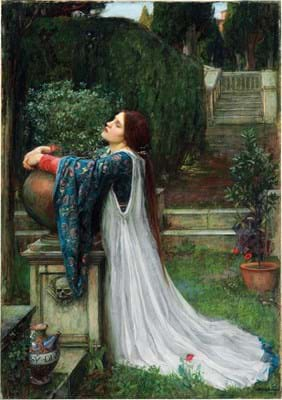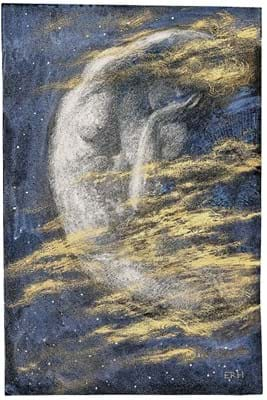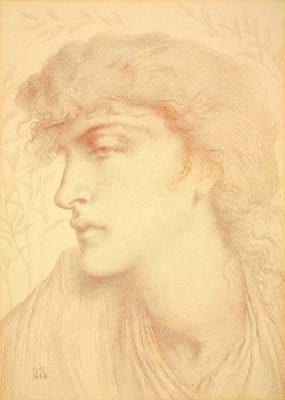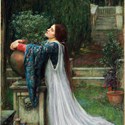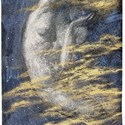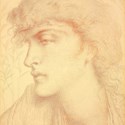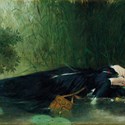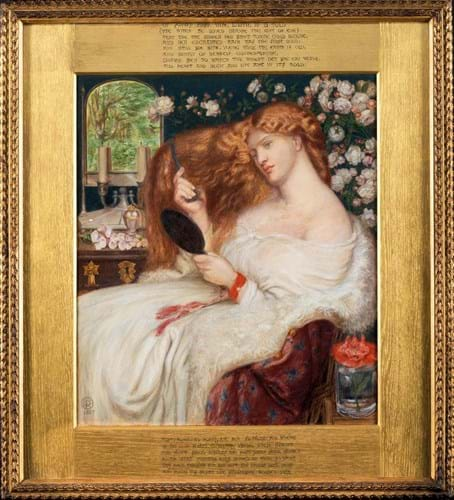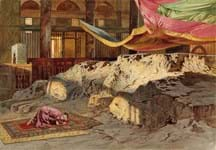Both Sotheby’s (25/20/12.5% buyer’s premium) and Christie’s (25/20/12% buyer’s premium) were topped by archetypal Pre- Raphaelite long-haired beauties: a £960,000 John William Waterhouse oil at Christie’s and a £560,000 watercolour by Dante Gabriel Rossetti at Sotheby’s. The latter made a meaty £445,000 increase on its last saleroom appearance in 1988.
Competition also filtered down to more modestly priced works by satellite names connected to the group.
Among those eagerly contested by bidders was a £40,000 portrait drawing by Simeon Solomon at Christie’s, while at Sotheby’s, two delicate watercolours appeared: of Selene as the moon by Edward Robert Hughes, and a nude sea nymph by Arthur Hopkins, sold at £115,000 and £72,000 respectively.
Outside this category, into the broader fields of Victorian painting and British Impressionists, fewer fireworks burst across both sales.
Demand for British artist Edward Seago was patchier than usual, with three out of six English and European views failing to sell at Sotheby’s, while Christie’s sold a number below hopes.
However, other British favourites such Alfred James Munnings and John Atkinson Grimshaw fared better, selling in line or occasionally above expectations.
Selective market
As many who work in the field will attest, buyer selectivity and sensitivity to pricing are part and parcel of today’s Victorian sales.
Sotheby’s July 13 sale totalled £2.64m, with both its star entries getting away, but was hampered by a low selling rate of around 60%.
Christie’s larger 117-lot sale two days earlier posted a 72% selling rate and totalled £2.97m.
“Sotheby’s and Christie’s sales were topped by archetypal Pre-Raphaelite long-haired beauties
Over £1m of Christie’s total came from the five Pre-Raphaelite oils consigned by Rod Stewart.
The most valuable painting of the series was his £1m-1.5m canvas Isabella and the Pot of Basil by John William Waterhouse (1849-1917).
The subject, a favourite of the Pre-Raphaelites, drew inspiration from a poem by John Keats, which was in turn adapted from Giovanni Boccaccio’s 14th-century novella Decameron. It tells the tale of Isabella, a young woman who buries the head of her murdered lover in a pot of basil.
Acquired by the singer-songwriter in 1981, the 3ft 5in x 2ft 5in (1.04m x 74cm) oil on canvas was billed by the auction house as an ‘outstanding example’ of Waterhouse’s mature period. The estimate proved a little eager however, and it got away just under at £960,000.
Better competition greeted a version of another favourite Pre- Raphaelite subject, Shakespeare’s heroine Ophelia. Painted by the lesserknown French artist Jean-Baptiste Bertrand (1823-87), the large 2ft 11in x 5ft 11in (89cm x 1.8m) oil on canvas caught the eye of several bidders, soaring to £78,000 against a £15,000- 25,000 guide. According to the Art Sales Index, the price is the second highest for the artist at auction.
Pre-Raphaelite drawings, consigned from a variety of sources, were well represented in the sale and generally achieved good prices.
Among the stand-out lots were a trio of late drawings by the Jewish artist Simeon Solomon (1840-1905), deaccessioned by the Ben Uri Gallery and Museum in London. The three portraits – Head of a youth, Dawn and another of the Italian painter Giotto – totalled £55,000.
The lion’s share came from the 15 x 11in (38 x 29cm) red chalk drawing of the youth, the most accomplished of the trio, which doubled its estimate to sell for £40,000.
Elsewhere, a set of four romantic compositional designs of lovers embracing by Edward Burne-Jones (1833-98) sold towards its upper guide at £45,000. The square 14in (36cm) watercolours were painted in rich tonal blues and may have been designs for a series of unexecuted relief panels.
Not all performed as strongly as predicted, however. Another of Burne-Jones’ drawings, The Garland, scraped away at £26,000 against hopes of £30,000-50,000.
It was one of a series of six that Burne-Jones painted in 1867, based on his designs for stained glass at the South Kensington Museum (now the V&A), which had been decorated by William Morris the previous year.
Rediscovered Rossetti
Much of the pre-sale talk at Sotheby’s centred on a version of Dante Gabriel Rossetti’s (1828-82) famous red-head seductress, Lady Lilith.
The 20 x 17in (51 x 43cm) watercolour, dated 1867, depicts Rossetti’s mistress Fanny Cornforth as Lady Lilith (a dangerous demon in Jewish mythology and the ‘first wife’ of Adam) combing her long hair.
This example, the last in private hands, had retained its original frame and a hand-written poem by Rossetti attached to the back. It had sold at auction in 1988 for £105,000 to Japanese businessman Tomonori Iwakura and changed hands just once since then.
Estimated at £400,000-600,000, it comfortably bettered its last price of 29 years ago, selling to a UK private buyer at £560,000.
The same buyer went on to secure another of Rossetti’s long-haired ‘Stunners’, a coloured chalk portrait of Louisa Ruth Maynard (1831-1921), known by her stage-name, ‘Miss Herbert’. It sold for £150,000 against a £70,000-100,000 guide.
Another top-end entry was George Frederick Watts’ (1817-1904) dramatic rendition of Ovid’s Orpheus and Eurydice. It was among the most significant Watts works to appear at auction in the last 15 years.
The 22in x 2ft 6in (56 x 76cm) oil on canvas depicts the moment when Orpheus, after journeying to the Underworld to lead his wife Eurydice back to Earth, gives in to the temptation to look at her despite knowing that if he did, she would be lost to him forever.
Watts made at least eight versions of the subject, with this picture thought to have been painted c.1870.
This painting remained in the artist’s possession until his death, passing to his adopted daughter where it remained in her family until it was acquired by the vendor in 1992.
It was secured by a UK private buyer for £260,000 against a £300,000-500,000 estimate.
Although below expectations, the price is the highest since Christie’s London sold a version of his celebrated canvas Hope in 2001 for £700,000 – the second-highest sum paid for the artist at auction.
Elsewhere, a work by another Symbolist painter, Edward Robert Hughes (1851-1914), met with greater competition. The Weary Moon, an 8½ x 5½in (22 x 14cm) watercolour of the goddess Selene in the shape of a crescent moon, was pursued to £115,000 – nearly triple its guide.
Consigned from a Spanish private collection, it had last sold for £9000 in 1989 at Sotheby’s Billingshurst.
According to the Telegraph, it was secured this time by the collector Isabel Goldsmith.


